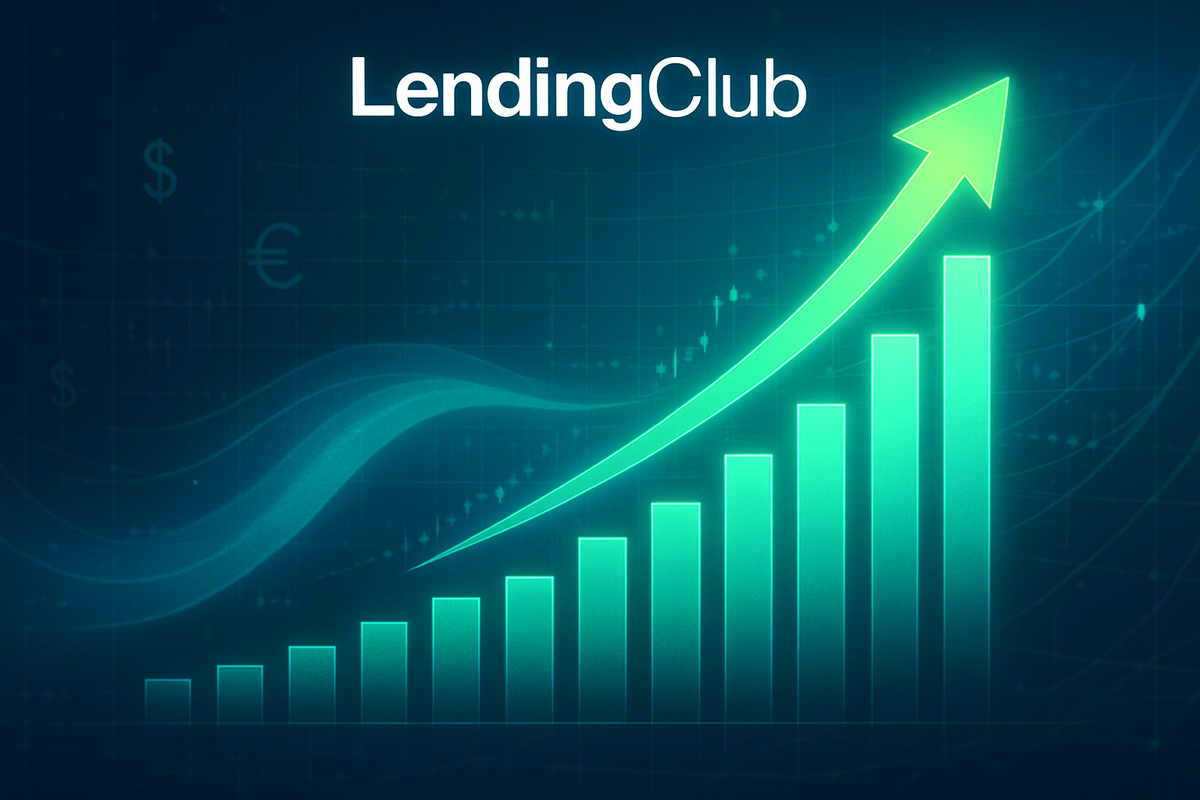
LendingClub (NYSE: LC) has recently reported a series of stellar financial results, igniting significant interest across the financial markets. With its third-quarter 2025 earnings report released on October 22, 2025, significantly surpassing analyst expectations, the digital marketplace bank has demonstrated robust growth across key metrics, sending its stock soaring. This surge in performance has prompted many to question whether this marks a definitive buying signal for investors looking for growth opportunities in the evolving fintech landscape.
The company's consistent outperformance in loan originations, revenue, and net income, coupled with strategic partnerships and product innovations, paints a compelling picture of a company hitting its stride. As of October 23, 2025, the market's reaction has been overwhelmingly positive, with shares experiencing a substantial jump and institutional confidence on the rise. This article delves into the specifics of LendingClub's financial surge, its broader implications for the market, and what lies ahead for the pioneering fintech firm.
LendingClub's Q3 2025 Triumphs and Market Acclaim
LendingClub's recent financial disclosures reveal a period of exceptional growth and operational efficiency. The third quarter of 2025, reported on October 22, 2025, showcased a remarkable 37% year-over-year increase in loan originations, reaching $2.6 billion. Total net revenue climbed to $266.2 million, a 32% rise from the previous year and notably above analyst estimates. Perhaps most impressively, net income more than tripled to $44.3 million, translating to a diluted earnings per share (EPS) of $0.37, far exceeding the anticipated $0.30.
This strong performance wasn't an isolated event. The preceding second quarter of 2025 also saw significant gains, with originations up 32% year-over-year to $2.4 billion and net income surging by 156% to $38.2 million. These back-to-back quarters of outperformance highlight a sustained growth trajectory. Key indicators such as Pre-Provision Net Revenue (PPNR) and profitability ratios like Return on Equity (ROE) and Return on Tangible Common Equity (ROTCE) consistently surpassed guidance and targets, underscoring the company's robust financial health and efficient operations. The expansion of its net interest margin to 6.18% in Q3 2025, driven by improved deposit funding costs, further solidifies its financial footing.
The market's response to these results has been immediate and enthusiastic. On October 23, 2025, LendingClub's (NYSE: LC) shares surged by 11%, bolstered by an upgrade from JPMorgan to an "overweight" rating. This follows a similar positive reaction after the Q2 2025 report, where shares jumped 15.94% in after-hours trading. The consistent positive momentum has seen LC stock reward long-term holders with a 27.4% increase over the last year and an impressive 179.5% gain over five years as of early October 2025. Institutional investors now hold a significant 74.08% of the company's stock, reflecting growing confidence in its future prospects.
Ripples Across the Financial Sector: Winners and Losers
LendingClub's impressive surge has significant implications for various players within the financial technology and traditional banking sectors. As a pioneering digital marketplace bank, LendingClub (NYSE: LC) stands out as a clear winner, demonstrating the viability and profitability of its hybrid model. Its ability to leverage technology for efficient loan origination and integrate with a bank charter for stable funding via deposits gives it a competitive edge. This success could further solidify its market share in the personal loan and balance transfer segments, potentially at the expense of traditional banks that are slower to adapt to digital-first strategies.
The company's strategic partnerships, such as the extended funding agreement with Blue Owl and the Memorandum of Understanding (MOU) with BlackRock-managed funds for up to $1 billion in marketplace investments, position these institutional investors as indirect beneficiaries. Their confidence in LendingClub's origination quality and growth potential validates the platform's model and ensures a steady supply of capital for future lending activities. This also signals a growing acceptance of fintech-driven lending models by major financial institutions.
Conversely, traditional banks and smaller, less agile online lenders could face increased competitive pressure. Banks that rely heavily on branch networks and legacy systems may struggle to match LendingClub's operational efficiency and speed in customer acquisition and loan processing. Other online lenders that lack a bank charter might find themselves at a disadvantage regarding funding costs and regulatory stability, especially in a fluctuating interest rate environment. The improved credit performance reported by LendingClub, which is 37% better than its competitors in Q3 2025, also suggests that it is attracting higher-quality borrowers, leaving a potentially riskier pool for other lenders.
Broader Significance and Industry Transformation
LendingClub's recent performance is not merely an isolated success story; it is a powerful indicator of broader trends reshaping the financial services industry. The company's hybrid model, combining a digital lending marketplace with a bank charter, exemplifies a successful convergence of fintech innovation and traditional banking stability. This model allows for diversified funding sources, including low-cost deposits, which mitigates reliance on volatile capital markets – a critical advantage in today's economic climate. This strategy is likely to become a blueprint for other fintechs seeking sustainable growth and regulatory compliance.
The strong institutional backing from players like BlackRock and Blue Owl further legitimizes the securitization and marketplace lending models within the broader financial ecosystem. This influx of institutional capital into LendingClub's platform suggests a growing confidence in the credit quality and underwriting capabilities of well-established fintech lenders. It could spur more partnerships between large asset managers and fintechs, driving further innovation and capital flow into the digital lending space. Regulatory bodies will likely continue to observe these developments closely, potentially influencing future guidelines around hybrid financial models and marketplace lending.
Historically, the financial industry has seen cycles of innovation and consolidation. LendingClub's current trajectory echoes the rise of other disruptive financial entities that successfully integrated technology to gain market share. Its focus on product innovation, such as the LevelUp Savings and Checking accounts, demonstrates a commitment to building a holistic financial relationship with its members, moving beyond just lending. This comprehensive approach positions LendingClub as a challenger not just in personal loans but potentially across a wider spectrum of consumer banking services, putting pressure on incumbent banks to accelerate their digital transformation efforts.
What Comes Next: Navigating Growth and Opportunity
Looking ahead, LendingClub (NYSE: LC) appears poised for continued expansion, with management guiding for sustained strong year-over-year growth in Q4 2025. The company anticipates total originations of $2.5-$2.6 billion, a PPNR increase of 21-35% year-over-year, and a significant improvement in ROTCE. These projections suggest that the management team is confident in its ability to maintain momentum, driven by its robust marketplace, efficient operations, and growing deposit base.
In the short term, investors will be closely watching the outcomes of LendingClub's Investor Day scheduled for November 5, 2025. This event is expected to provide deeper insights into the company's strategic vision, product roadmap, and long-term financial targets, which could further influence market sentiment and stock valuation. Continued expansion of its LevelUp suite of products and potential new offerings will be key indicators of its strategic pivot towards becoming a full-service digital bank for its target demographic.
Long-term possibilities include further diversification of its loan products, potential expansion into small business lending, or even strategic acquisitions to bolster its technological capabilities or customer base. The market opportunities for LendingClub lie in its ability to continuously innovate and scale its hybrid model while maintaining superior credit quality and operational efficiency. Challenges may arise from increased competition from both traditional banks enhancing their digital offerings and emerging fintechs, as well as potential shifts in interest rates or regulatory environments that could impact lending volumes and profitability. Investors should monitor the company's ability to manage credit risk effectively, especially as it scales, and its success in retaining and growing its customer base through its integrated banking products.
A Resilient Fintech Powerhouse: Final Thoughts for Investors
LendingClub's recent financial surge represents a compelling narrative of a fintech company successfully navigating market complexities and executing a robust growth strategy. The consistent outperformance in originations, revenue, and profitability, coupled with strategic institutional partnerships, underscores the strength and scalability of its unique digital marketplace bank model. As of October 23, 2025, the market has responded with enthusiasm, signaling a strong belief in the company's future potential.
For investors, LendingClub's current trajectory suggests a company with significant upside. Its ability to generate strong earnings growth, expand net interest margin, and improve efficiency ratios positions it favorably in the competitive financial landscape. The positive analyst upgrades and increasing institutional ownership further reinforce the perception of LendingClub (NYSE: LC) as a potentially undervalued asset with substantial long-term growth prospects. The company's strategic emphasis on product innovation and building a sticky customer base through its LevelUp offerings indicates a forward-thinking approach to sustainable expansion.
Moving forward, investors should closely monitor LendingClub's execution against its Q4 2025 guidance, the details emerging from its Investor Day, and its continued ability to attract and retain deposits to fuel its lending activities. The evolution of its product suite and any further strategic partnerships will also be crucial indicators of its long-term growth trajectory. While past performance is not indicative of future results, LendingClub's recent surge presents a compelling case for consideration by investors seeking exposure to a resilient and innovative player in the fintech sector.
This content is intended for informational purposes only and is not financial advice






